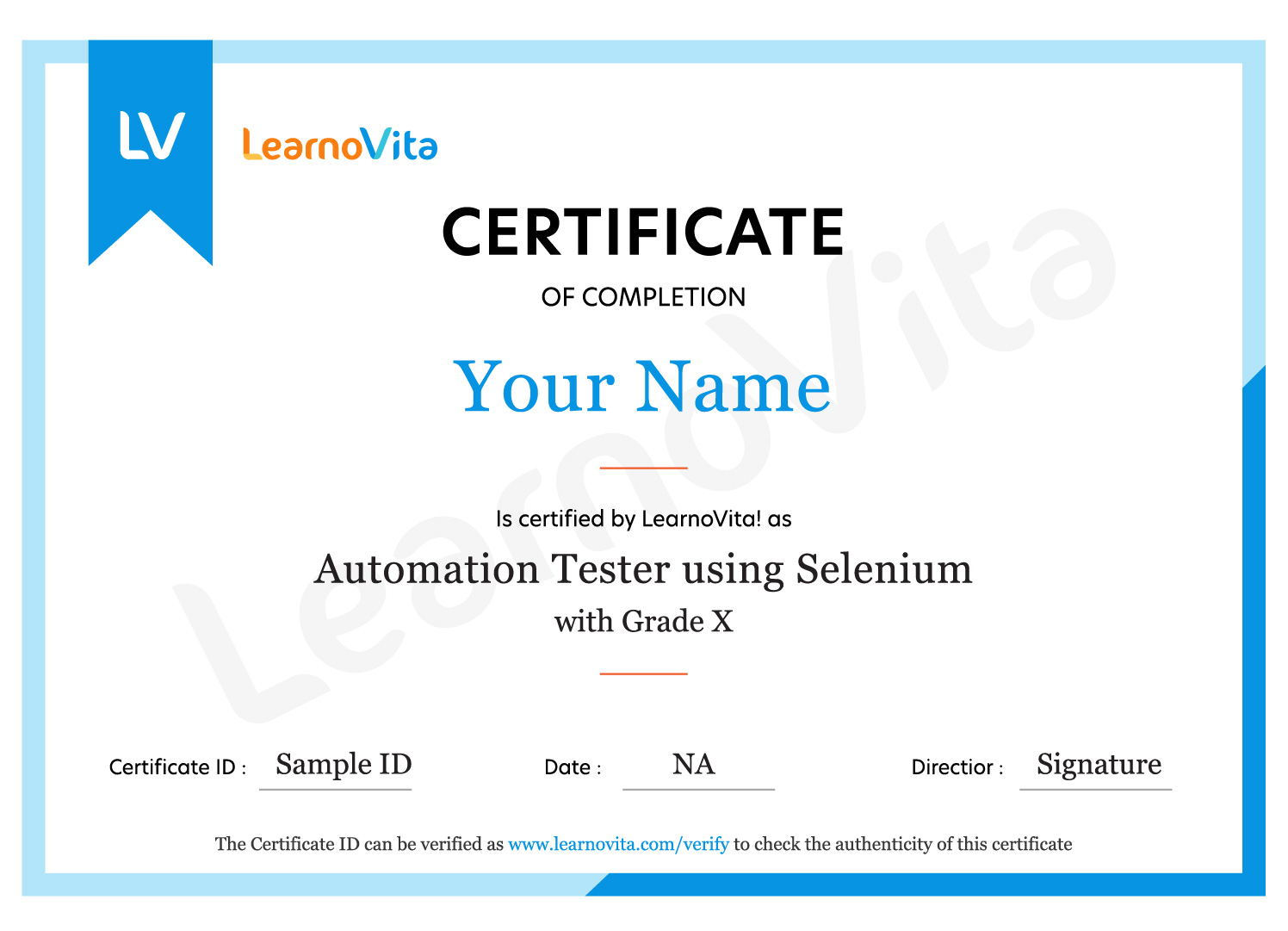A Comprehensive of Manual Testing Course Overview
Learnovita’s Manual Testing Course in Pune offers a thorough and practical approach to mastering manual testing methodologies. This comprehensive program covers essential topics, including test case design, defect tracking, and functional testing, providing participants with hands-on experience through real-world scenarios. Students benefit from Learnovita’s robust placement support, including resume building and interview preparation, to enhance career prospects. Our Manual Testing training in Pune is designed to meet industry demands with expert-led sessions and practical exposure. Whether you are a beginner or looking to advance your skills, this Manual Testing course equips you with the expertise needed to excel in the field of manual testing.This Manual Testing certification course in Pune provides globally recognized training to build a solid QA foundation.Gain the confidence and skills needed to succeed in testing roles across diverse domains.
Additional Info
The Evolution of Manual Testing Management: Latest Trends and Techniques
- Integration of Agile Methodologies:
Manual testing management is increasingly aligning with Agile methodologies to enhance flexibility and collaboration. Agile practices, such as iterative testing and continuous feedback, enable manual testers to adapt quickly to changes and improve testing efficiency. Test managers now incorporate Agile principles to ensure that testing cycles align with development sprints, fostering better communication between teams. This shift facilitates early defect detection and resolution, ultimately leading to higher-quality software releases. The integration of Agile also promotes a more dynamic and responsive testing environment.
- Adoption of Test Automation Tools:
Although manual testing is still essential, there is an increasing shift towards incorporating test automation tools to complement manual efforts. These tools improve testing coverage and efficiency, allowing manual testers to concentrate on complex scenarios that require human insight. Automation also helps manage large volumes of test cases and supports continuous integration and deployment practices. Test managers are increasingly adopting these tools to refine their testing strategies and streamline workflows. Combining manual and automated testing provides a balanced approach to quality assurance.
- Focus on User Experience Testing:
Advancements in manual testing management are placing a greater emphasis on user experience (UX) testing to ensure software meets end-user expectations. Manual testers are now more involved in assessing usability, accessibility, and overall user satisfaction. This shift involves creating detailed user personas and scenarios to simulate real-world interactions with the software. Test managers are integrating UX testing into their strategies to address user feedback and enhance the overall quality of the product. This approach helps deliver software that is not only functional but also user-friendly.
- Enhanced Test Case Management:
Effective test case management is becoming a focal point in manual testing management to improve test planning and execution. Advanced test case management tools and methodologies are being adopted to organize and track test cases more efficiently. These tools provide features for test case creation, execution, and defect tracking, enabling testers to maintain comprehensive documentation. Improved test case management helps ensure that all requirements are covered and facilitates better test coverage analysis. Test managers are leveraging these tools to streamline the testing process and provide thorough validation of software features. Enhanced management practices contribute to more organized and effective testing efforts.
- Emphasis on Continuous Testing Practices:
Continuous testing is gaining traction in manual testing management, aligning testing efforts with continuous integration and continuous deployment (CI/CD) practices. This approach involves integrating manual testing activities into the CI/CD pipeline to provide ongoing feedback throughout the development cycle. Continuous testing helps in identifying defects early and ensures that software quality is maintained as new features are introduced. Manual testers play a crucial role in executing test cases and validating functionality in this dynamic environment. This advancement promotes a more proactive approach to quality assurance.
- Utilization of Cloud-Based Testing Environments:
Cloud-based testing environments are becoming increasingly popular in manual testing management for their flexibility and scalability. These environments provide on-demand access to various testing resources and configurations, allowing manual testers to conduct tests across different platforms and devices. Cloud-based testing also enables remote collaboration, facilitating seamless communication and coordination among distributed testing teams. Test managers are leveraging cloud solutions to reduce infrastructure costs and improve testing efficiency. The scalability of cloud-based environments supports large-scale testing and provides the ability to adapt to changing requirements quickly.
- Integration of Artificial Intelligence (AI) and Machine Learning (ML):
Artificial Intelligence (AI) and Machine Learning (ML) are beginning to influence manual testing management by offering advanced analytics and predictive capabilities. AI and ML technologies can assist in identifying patterns, predicting defect occurrences, and optimizing test case selection. These technologies help manual testers by providing insights into potential risk areas and automating repetitive tasks. Test managers are exploring AI and ML to enhance their testing strategies and improve decision-making processes. The integration of AI and ML supports more efficient and targeted testing approaches, ultimately contributing to higher software quality. This technological advancement is shaping the future of manual testing management by augmenting human expertise with intelligent solutions.
Career Opportunities in Manual Testing with Top Firms
- IBM:
As a leading technology and consulting firm, IBM values quality assurance and rigorous testing processes to maintain its high standards. IBM manual testers work on diverse projects, including software development, system integration, and performance optimization. They engage in comprehensive testing phases, from requirement analysis to defect management. IBM provides a collaborative environment with access to cutting-edge tools and technologies. The company's global presence and innovation-driven culture offer ample growth opportunities for manual testing professionals.
- Accenture:
The company emphasizes the importance of thorough testing to ensure the quality and reliability of client solutions. Manual testers at Accenture work on various applications, including enterprise software, cloud solutions, and digital platforms. They participate in all stages of the testing lifecycle, including test planning, execution, and reporting. Accenture’s commitment to innovation and continuous improvement provides a dynamic work environment. The firm offers extensive career development programs and opportunities to work with leading technologies and methodologies.
- TCS (Tata Consultancy Services):
TCS is a global IT services and consulting company that hires manual testers for its wide range of projects across multiple industries. Manual testers at TCS are involved in detailed testing processes, including functional, regression, and system testing. TCS provides access to advanced testing tools and technologies, enhancing the efficiency and effectiveness of manual testing. The firm’s extensive client base and global reach offer diverse career opportunities and growth prospects. TCS’s focus on employee development and training supports continuous professional advancement.
- Infosys:
Manual testers at Infosys work on various projects, including software applications, enterprise systems, and digital platforms. The company emphasizes comprehensive testing approaches, from test design and execution to defect tracking and reporting. Infosys provides a supportive work environment with opportunities for career growth and skill development. Testers have access to a range of tools and technologies that enhance their testing capabilities. Infosys’s global presence and diverse project portfolio offer valuable experiences and career advancement opportunities.
- Capgemini:
Manual testers at Capgemini are involved in various testing activities, including functional, integration, and user acceptance testing. The company’s focus on delivering innovative solutions requires meticulous testing to meet client expectations. Capgemini offers a dynamic work environment with opportunities to work on cutting-edge projects and technologies. Testers benefit from extensive training programs and career development resources. Capgemini’s global network and client diversity provide ample opportunities for career growth and specialization.
- Wipro:
Wipro is a prominent IT services and consulting company that values manual testing to deliver high-quality solutions. Manual testers at Wipro engage in various testing activities, including system, integration, and performance testing. Wipro provides a collaborative environment with access to advanced testing tools and methodologies. The firm’s global reach and diverse client base offer extensive career opportunities and professional growth. Wipro’s focus on employee development and innovation supports continuous career advancement.
- Cognizant:
Cognizant, a leading technology and consulting firm, hires manual testers for its extensive range of projects across different industries. Manual testers at Cognizant work on various aspects of testing, including functional, regression, and exploratory testing. The company emphasizes the importance of thorough testing to ensure the quality and performance of client solutions. Cognizant provides a supportive work environment with opportunities for career growth and skill enhancement. Testers benefit from access to modern testing tools and technologies. The firm’s global presence and diverse project portfolio offer valuable experiences and advancement opportunities.
- Deloitte:
Manual testers at Deloitte are involved in comprehensive testing processes, including functional, integration, and user acceptance testing. The company offers a collaborative work environment with access to cutting-edge tools and technologies. Deloitte’s focus on delivering quality solutions requires meticulous testing and attention to detail. Testers benefit from extensive training programs and career development resources. The firm’s global reach and diverse client base provide ample opportunities for career advancement and specialization.
- HP (Hewlett Packard):
HP is a global technology company that employs manual testers to ensure the quality and performance of its products and solutions. Manual testers at HP work on various projects, including software applications, hardware systems, and integrated solutions. The company’s focus on innovation and quality assurance involves rigorous testing processes to meet high standards. HP provides a dynamic work environment with opportunities for career growth and professional development. Testers have access to advanced testing tools and methodologies that enhance their capabilities. HP’s global presence and diverse project portfolio offer valuable experiences and career advancement opportunities.
- Oracle:
Oracle, a leading provider of database and software solutions, hires manual testers to ensure the quality and reliability of its products. Manual testers at Oracle are involved in various testing activities, including functional, integration, and performance testing. The company emphasizes the importance of thorough testing to maintain its high-quality standards. Oracle provides a collaborative work environment with access to state-of-the-art testing tools and technologies. Testers benefit from extensive training programs and career development opportunities. Oracle’s global presence and diverse project portfolio offer valuable experiences and career growth prospects.
Manual Testing Key Tools and Technologies You Need
- TestRail:
It enables testers to create detailed test plans, execute tests, and track results in an intuitive interface. The tool offers advanced reporting capabilities, allowing teams to generate customized reports on test progress and defect metrics. TestRail integrates seamlessly with various bug-tracking and project management tools, enhancing overall testing efficiency. Its collaborative features support team communication and ensure that testing activities are well-coordinated. TestRail is essential for maintaining organized and effective manual testing workflows.
- JIRA:
JIRA is a popular project management and issue-tracking tool that is widely used in manual testing environments. It allows testers to log and track defects, manage test cases, and monitor progress through customizable workflows. JIRA’s integration with various testing and development tools helps teams maintain visibility into testing activities and defect resolutions. Its reporting features provide insights into test performance and defect status. JIRA also facilitates collaboration between testers, developers, and project managers, ensuring a cohesive approach to quality assurance. The tool is crucial for managing testing efforts and addressing issues effectively.
- TestLink:
TestLink is an open-source test management tool that supports the creation, execution, and tracking of test cases. TestLink’s integration with bug-tracking systems facilitates efficient defect management and resolution. The tool supports test execution reporting, offering insights into test coverage and results. Its user-friendly interface and flexible configuration options make it a valuable asset for managing manual testing activities. TestLink helps ensure thorough and organized testing processes.
- QTest:
QTest is a robust test management tool designed to enhance the efficiency of manual testing processes. It offers features for creating and managing test cases, executing test runs, and tracking defects. QTest’s real-time dashboards and reporting capabilities provide visibility into test progress and quality metrics. The tool integrates with various development and CI/CD tools, facilitating seamless workflows between testing and development teams. QTest’s collaboration features support effective communication and coordination among team members. Its comprehensive test management capabilities help ensure thorough and effective quality assurance.
- Zephyr:
It provides a centralized platform for organizing test cases, planning test cycles, and tracking test results. Zephyr’s detailed reporting features help teams monitor test progress and identify areas for improvement. The tool supports various testing methodologies and integrates with other testing tools for streamlined workflows. Zephyr’s user-friendly interface and robust functionality make it a popular choice for managing manual testing efforts. It ensures efficient and effective test management practices.
- ALM Octane:
ALM Octane is a comprehensive application lifecycle management tool that supports manual testing and quality assurance processes. It offers features for managing test cases, tracking defects, and reporting on test progress. ALM Octane’s integration with development and project management tools facilitates seamless communication and coordination. The tool provides advanced analytics and reporting capabilities, enabling teams to gain insights into testing effectiveness and quality metrics. Its flexible configuration options support various testing methodologies and workflows. ALM Octane is essential for managing complex testing projects and ensuring high-quality outcomes.
Core Responsibilities and Duties of Manual Testing Experts
- Designing Test Cases and Scenarios:
Manual testing professionals are responsible for designing detailed test cases and scenarios that reflect real-world use cases of the software. This involves understanding the software requirements and user expectations to create effective test scripts. By drafting comprehensive test cases, they aim to uncover defects and ensure the software meets quality standards. The test cases must be clear, concise, and well-documented for effective execution. This meticulous planning is crucial for identifying potential issues early in the development cycle.
- Executing Test Cases and Reporting Defects:
Once test cases are designed, manual testers execute them to verify that the software functions as intended. They systematically follow the test scripts, inputting data and documenting the actual outcomes. If discrepancies or defects are found, they meticulously record the issues with detailed descriptions and steps to reproduce. These defect reports are crucial for the development team to understand and address the problems. Testers must prioritize defects based on their severity and impact on the system. Effective communication of issues helps ensure prompt resolutions and improves overall software quality.
- Collaborating with Development and QA Teams:
Manual testing professionals frequently collaborate with developers and other QA team members to understand requirements and discuss test findings. They participate in team meetings to provide insights into test results and defect statuses. This collaboration helps align testing efforts with development goals and project timelines. Testers work closely with developers to reproduce issues and verify fixes. By maintaining open communication, they contribute to a more streamlined development and testing process. This teamwork ensures that the final product meets user expectations and quality standards.
- Validating User Interface and User Experience:
Manual testers are essential in assessing the software's user interface (UI) and user experience (UX). They evaluate usability by analyzing the software’s layout, navigation, and overall design to confirm it aligns with user expectations. Testers determine how intuitive and user-friendly the interface is and identify opportunities for improving the UX. They also verify that the software adheres to design specifications and accessibility requirements. Guaranteeing a positive user experience is essential for user satisfaction and software success. Their feedback is crucial for refining the product to address user needs better.
- Conducting Exploratory Testing:
Exploratory testing involves manual testers exploring the software without predefined test cases to uncover unexpected issues. Testers use their creativity and intuition to identify potential problems that structured testing might miss. This approach allows them to interact with the software in ways that reflect real-world usage. Exploratory testing can reveal critical issues related to usability and functionality that might not be evident through scripted tests. Testers document their findings and share insights with the development team. This form of testing complements structured testing by providing additional perspectives on software quality.
- Maintaining Test Documentation and Artifacts:
Manual testers are responsible for maintaining comprehensive test documentation, including test plans, cases, and execution logs. They ensure that all testing artifacts are well-organized and updated to reflect current test status and results. Proper documentation aids in tracking testing progress, managing test coverage, and providing evidence for quality assurance activities. Test records are also valuable for audits, future reference, and knowledge transfer. Adequate documentation supports transparency and accountability in the testing process. It helps review and improve testing practices over time.



















 Regular 1:1 Mentorship From Industry Experts
Regular 1:1 Mentorship From Industry Experts




